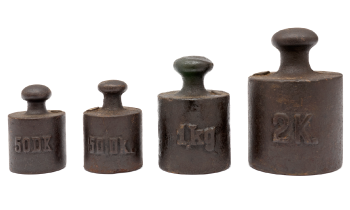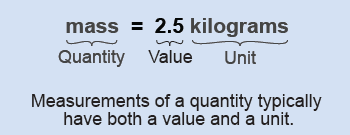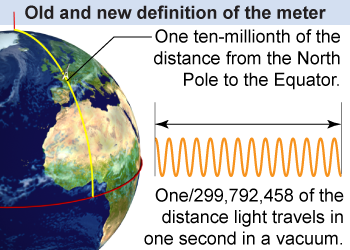|
 A measurement of a physical quantity involves a comparison with a standard of measurement. The standard of measure for the kilogram is one particular cylinder of platinum alloy held by the International Bureau for Weights and Measures (BIPM). If an object has a mass of 7.3 kg, then that means that its mass is 7.3 times larger than the BIPM’s standard mass.
A measurement of a physical quantity involves a comparison with a standard of measurement. The standard of measure for the kilogram is one particular cylinder of platinum alloy held by the International Bureau for Weights and Measures (BIPM). If an object has a mass of 7.3 kg, then that means that its mass is 7.3 times larger than the BIPM’s standard mass. 
|
 A measurement of a quantity, such as mass, communicates how much there is. Measurements nearly always have two parts: a value and a unit (or dimension). Consider a quantity of mass of 2.5 kg. The number, 2.5, is the value and kilograms is the unit. All measurements need units because, without a unit, the value of the measurement cannot be understood. For example, describing a rock as having a mass of 2.5 makes no sense. You could be talking about a 2.5 g pebble or a 2.5 ton, car-sized boulder.
A measurement of a quantity, such as mass, communicates how much there is. Measurements nearly always have two parts: a value and a unit (or dimension). Consider a quantity of mass of 2.5 kg. The number, 2.5, is the value and kilograms is the unit. All measurements need units because, without a unit, the value of the measurement cannot be understood. For example, describing a rock as having a mass of 2.5 makes no sense. You could be talking about a 2.5 g pebble or a 2.5 ton, car-sized boulder. 
|
Whenever a value is communicated in science there should be some information to answer the question, “What are the units of this quantity?” For example, a sign for gasoline in Mexico may quote an equivalent price of USD$1.25. You must ask, however, whether that is per gallon or per liter! There will be some fine print on the sign that says “per liter.” There are 3.78 liters in a gallon, so $1.25/liter = $4.72/gallon. Always seek clarification on units if you are not given that information. 
|
The dimensions of a physical quantity are the fundamental quantities that comprise it. The dimension of speed is length divided by time, while the dimension of volume is length cubed (or length times length times length). The dimension of density is not mass divided by volume, because volume is not a fundamental quantity. Instead, the dimension of density is mass divided by length cubed. 
|
 The meter was originally defined as one ten-millionth of the distance from the North Pole to the Equator. The second was originally defined in terms of a day: one solar day = 86,400 s. As experiments became more accurate, both definitions became too imprecise. Today, one second is defined as the duration of 9,192,631,770 periods of the radiation corresponding to the transition between the two hyperfine levels of the ground state of the atom cesium-133. One meter is defined as the distance traveled by light in a vacuum during a time interval of 1/299,792,458 of a second. These modern definitions allow experimenters to compare measurements of length or time to within one part per billion.
The meter was originally defined as one ten-millionth of the distance from the North Pole to the Equator. The second was originally defined in terms of a day: one solar day = 86,400 s. As experiments became more accurate, both definitions became too imprecise. Today, one second is defined as the duration of 9,192,631,770 periods of the radiation corresponding to the transition between the two hyperfine levels of the ground state of the atom cesium-133. One meter is defined as the distance traveled by light in a vacuum during a time interval of 1/299,792,458 of a second. These modern definitions allow experimenters to compare measurements of length or time to within one part per billion. 
|
If F is the symbol for force and v is the symbol for velocity, what does the following equation describe? - Mass divided by velocity times time is equal to force.
- Force is equal to mass times time divided by velocity.
- Velocity times time is equal to force and mass.
- Force is equal to mass times velocity divided by time.
 |
The correct answer is d. 
|
| |
|

